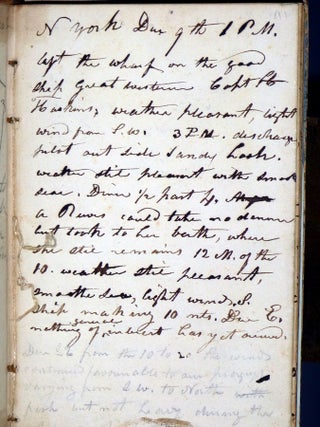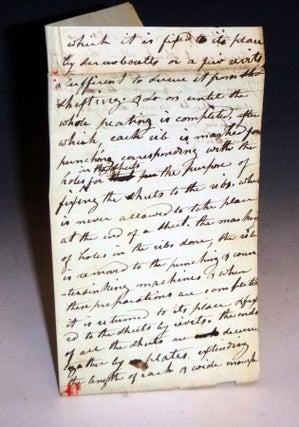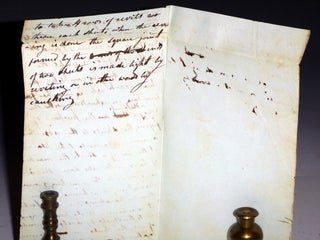Diary, December 9, 1840-June 16, 1841
Small Octavo. Item #027730
Diary of Samuel James Reeves, Iron Master, who became the chief officer of the Phoenix Iron Company of Phoenixville, Pennsylvania. approximately 141 pages (some at the end are written upside down)-a special page is inserted. He was the son of David Reeves, President, who designed the Phoenix column. In this diary, he was sent to visit the chief iron and steel manufacturing centers in Europe. Note: The front pastedown has pencil notes and a drawing of pillars. Since the diary is unnumbered, we have supplied in light pencil page numbers for each leaf on the recto of each succeeding page. The initial pages (1-13 deal with the voyage from New York to England) N [ew] York Dec 9th [1840] 1 PM left wharf on good ship Great Western. Travels to iron and ship manufacturers in England and France. Initially, he notes ships carrying large amounts of coal 30 to 50 tons, and the size of the ship's sail, the coal from Newcastle to London was on ships of 200 to 300 tons and so built alike, hard to distinguish. At this point, he begins to assiduously note not only the construction of ships with their increased use of steel but all types of manufacture. The details are made in light of his already considerable knowledge of steel development in the U.S. Many good details such as measurements, forming, etc. p. 14-18. Lyons Jan 17, 1841 notes in detail the strengths and weaknesses of the Bridge at St.[??-not Ainay??] [19-21 visits Montpellier and notes the wood machines used in producing fabrics, which he sees as primitive, describing the horrendous conditions of the workers--botanical garden-St. Peter's Cathedral. Precise details are given on iron and steel manufacture on these pages. His keen observations as someone in the manufacture of steel make this essential. 1/27-34/41 left for Nimes, describes ironworks which consists of 4 blast furnaces, describes the two operation, variations, also nearby rolling mill works, railroad bars, car axles, dimensions of furnace photo page 23. A thorough description of how their blast furnace works. Marseilles, Naples, Genoa [axel broke, my note of the irony involved], he then visited various craters and volcanoes with astute observations of gasses and formations, p. 68-69 observes ancient pillars of Rome with exact measurements and observations, geologic note. Continues travels to Rome and Florence. Here he makes his most important observations on his inspection of the first large vessel to use the screw propeller. This was allowed due to the kindness of the Chief Engineer Clifton May 20, p. 103-105 visited yard of Great Western Steam Navigation, this morning shown great warship being constructed ["the first large vessel built of iron and also the first to use the screw propeller"] -he writes: "experimenting on the efficiency of her propeller" .... 'this morning I was permitted to visit due to the kindness of Thomas R. Guppy, [C.E.] (who constructed the Great Western that was not launched until July 1843-[there are pictures online of this boat called the Archimedes]. Clifton to Newport p. 106-119 note--important observations Now he notes the huge manufacturing in the ironworks district. 119-to Birmingham & Wolverhampton extensive ironworks district-100 blast furnaces, 25 of which through the kindness of Mr. Livich, the manager was about to see in Springvale extensive works, consisting of four blast furnaces, of which is made into merchant sheets of rods-the build in which the pudding is done, while open on all sides of which there are 24 pudding furnaces in one range-set back to back, the flues of each carried up in the stack separate, --general sketch [see digital images] He notes 100 tons of ¼" nail rods made in six days- p. 125-132. June 29 1841 Liverpool, called on Mr. Pierce deputy, moving date, called on Mr. Javonson who has a furnace in? (near that of Mr. C. Granes 50 tons a week fall Viver Iron Co-note insert reverse pages at the end, drawing, Momentshire Iron & Coal Co., and he notes wages paid. While the text is technical, it illustrates the advances being made in the early 1840s and how the youthful Samuel James Reeves had sufficient engineering expertise to recognize how these developments could be applied to their U.S. operations. Bound in 1/4 calf over marbled paper covered boards, boards rubbed.
Price: $6,500.00






